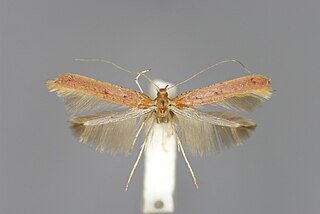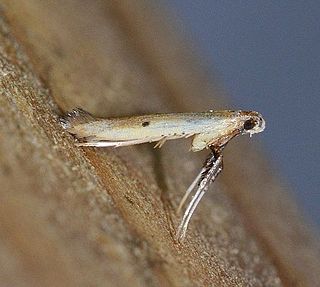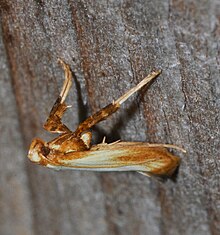
Gracillariidae is an important family of insects in the order Lepidoptera and the principal family of leaf miners that includes several economic, horticultural or recently invasive pest species such as the horse-chestnut leaf miner, Cameraria ohridella.

Cydia saltitans or jumping bean moth is a moth from Mexico that is most widely known as its larva, where it inhabits the carpels of seeds from several related shrubby trees, mainly Sebastiania pavoniana or Sapium biloculare. These seeds are commonly known as Mexican jumping beans.

Caloptilia azaleella is a moth of the family Gracillariidae. It is endemic to Japan, but has been introduced worldwide, wherever there are Azaleas.

Parornix anglicella is a moth of the family Gracillariidae found in Asia and Europe. It was described in 1850, by the English entomologist Henry Tibbats Stainton, from a specimen from Lewisham, Kent.

Caloptilia populetorum is a moth of the family Gracillariidae. It is found in most of Europe, except Italy, the Balkan Peninsula and the Mediterranean islands.

Caloptilia elongella is a moth of the family Gracillariidae. It is known from all of Europe east to eastern Russia. It is also found in North America from British Columbia, south to California and east in the north to New Hampshire and New York.
Caloptilia octopunctata is a species of moth of the family Gracillariidae. It is known from the Democratic Republic of Congo, Tanzania, Uganda, South Africa, India, Australia, New Zealand and Indonesia.

Caloptilia cecidophora is a moth of the family Gracillariidae. It is known from Japan and Taiwan.
Caloptilia alnivorella, the alder leafminer, is a moth of the family Gracillariidae. The species was first described by Vactor Tousey Chambers in 1875. It is known from the Russian Far East, Canada and the United States.

Caloptilia violacella is a moth of the family Gracillariidae. It is known from Illinois, Missouri, Florida, Georgia, Kentucky, Maine, Maryland, New York and Texas in the United States.
Caloptilia diversilobiella is a moth of the family Gracillariidae. It is found in the United States (California).
Caloptilia ferruginella is a moth of the family Gracillariidae. It is known from the United States (California).
Caloptilia fraxinella is a moth of the family Gracillariidae. It is known from Canada and the United States.
Caloptilia scutellariella is a moth of the family Gracillariidae. It has been recommended that this species be further studied as its placement within the genus Caloptilia is in need of clarification. It is known from Ontario, Canada, and Ohio and Michigan in the United States.
Caloptilia porphyretica is a moth of the family Gracillariidae. It is known from North Carolina and New Jersey in the United States.
Caloptilia ostryaeella is a moth of the family Gracillariidae. It is known from Québec, Canada, and Kentucky, Maine, Ohio and Vermont in the United States.
Caloptilia perseae is a moth of the family Gracillariidae. It is known from Cuba and Florida in the United States.

Mary Esther Murtfeldt was an American entomologist, botanist, botanical collector, writer and editor. She undertook research on the life histories of insects, describing several species new to science and wrote extensively on entomology. Murtfeldt created a collection of plant specimens that contributed to the scientific knowledge on the plants of Missouri.

Gracillariinae are a subfamily of moths which was described by Henry Tibbats Stainton in 1854.
Scrobipalpopsis tetradymiella is a moth in the family Gelechiidae. It was described by August Busck in 1903. It is found in North America, where it has been recorded from California, Arizona and Nevada.









